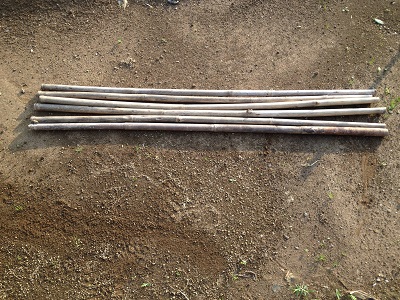 Bamboo Bamboo
Bamboo sounds like one of the noises made when people got hit in the old Batman
shows, you know....biff....boffo....bam....bamboo. Maybe even a good word
around Halloween when you blow something up and try to scare someone at the same
time.
Actually bamboo is a group of flowering perennial evergreen plants in the grass family.
Bamboos are some of the fastest-growing plants in the world. Certain species of
bamboo can grow 35 inches or more within a 24-hour period. This means plenty of bamboo
to go around for all your projects.
Bamboo has a higher compressive strength than wood, brick, or concrete and a
tensile strength that rivals steel.
Tanegashima island has tons of bamboo pretty much everywhere you
look....literally everywhere. In fact, over many year on the island, you might
say that I developed a love hate relationship for the stuff. Bamboo is
incredibly invasive, sending out runners and popping everywhere you don't want
it....the hate aspect. On the other hand, certain types of bamboo are extremely
useful for building things, especially in the farm and garden....the love
aspect.
After moving to the island, it became evident that most things were much more
expensive in this little corner of the world than on mainland Japan thanks to
the sending fees to this semi remote place. Another realization was the need for wood, or at
least some type of building materials, for farming and other house projects,
like keeping our very active puppies out of the neighbors farms. The choice was
spending hundreds of dollars on wood from the over priced building supply store
or find an alternative. Bamboo was the answer.
The bamboo pieces shown in the picture were up to four meters long and full of
leaves before being cut. Once processed, the poles can be used in many different
ways. The following are a few ideas I came up with for this
incredibly versatile resource. |
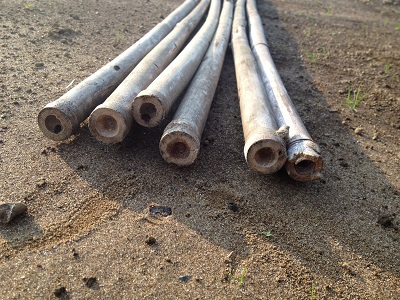 Preparing
Bamboo Preparing
Bamboo
Preparing bamboo is pretty much the easiest thing you could ever imagine. Nature
was kind enough to design this perfectly, taking away all worries of where to
cut, tie, or use. Why is this stuff so easy to use? Because bamboo has nodes located between the long hollow sections.
The nodes of a piece of bamboo are the ring looking bands at irregular intervals
from which the branches and leaves grow. These bands are usually solid all the
way through
the bamboo and very important for doing projects.
Bamboo needs to be properly prepared before use. The long thin end, the thick
open section where it was cut during harvesting, and any roots, all need to be
trimmed off before beginning. Then the piece needs to be cut to the desired
length.
Where you cut a piece of bamboo really depends on your project.
For projects requiring a hollow piece of bamboo, cut halfway, or any distance
between two consecutive nodes.
For projects where you do not want anything to enter your piece of bamboo,
such as soil or insects, cut as close to a node as possible, and on the outsides
of the nodes on the piece you plan to keep and use. This will leave a mostly
solid opening at the end of the bamboo. Tanegashima island has certain species
of wasps which like to move into open pieces of bamboo. When the ends are closed
they eventually give up and leave. |
|
|
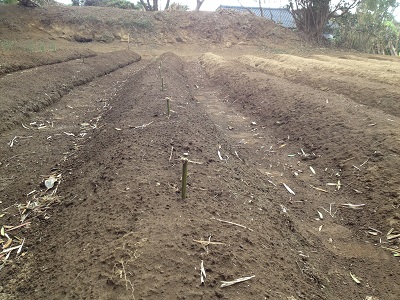 Bed Divider Bed Divider
Long farm beds can easily be divided to separate vegetables using a small bamboo
stick. This makes it easy to differentiate the identical seedlings of different
vegetables once they appear.
For example, growing several types of white radishes (daikon) or maybe lettuce
in the same bed can be somewhat problematic when it comes to figuring out where
each variety was sown. Using these handy little pieces of bamboo makes it much
easier.
The long straight beds (now using a square bed design) in my farm were about 12 meters long, way too much space
for one veggie. The bed shown in the picture was used for leafy veggies which could all
be grown together. Separating the veggies using bamboo made it easier to
maintain and harvest.
Be sure to cut the bamboo directly on the
outer sides of each node. This results in a closed piece of bamboo at each end
and keeps soil from getting into the hollow section. |
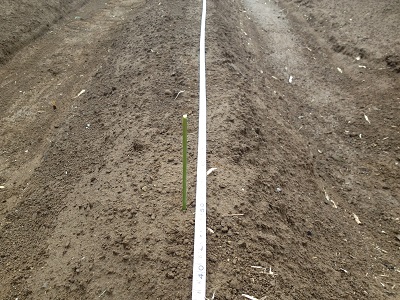 Seed
Spacer Seed
Spacer
When planning out farm beds there typically needs to be a certain distance
between vegetables, for example 50 cm for broccoli.
Use a strong, thin piece of bamboo to make holes in the soil at the regular
intervals you need or simply use a lot of bamboo pieces and keep them in the
soil until you are ready to put in seeds or seedlings. |
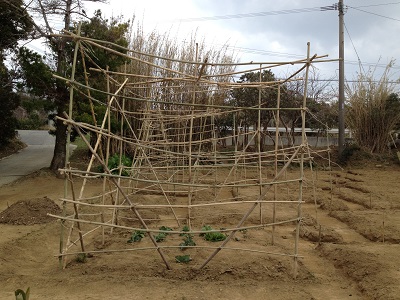 Vine Support Trellis Vine Support Trellis
After a year of farming, I was ready to grow up....um the vines that is. Yup
vertical farming is one of my favorite ways to utilize space and keep the
veggies off the ground.
Bamboo worked out fantastic for this project. I simply cut the pieces and tied
them together with jute. |
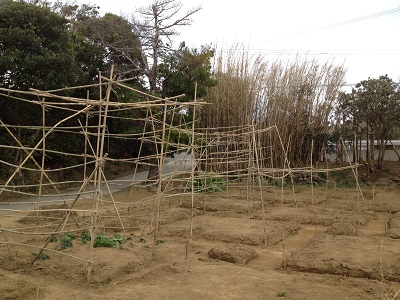 Full
View Full
View
The support trellis not only kept the Summer veggies off the ground but when
covered with bamboo leaves, it made a nice wind barrier during the cooler
months. |
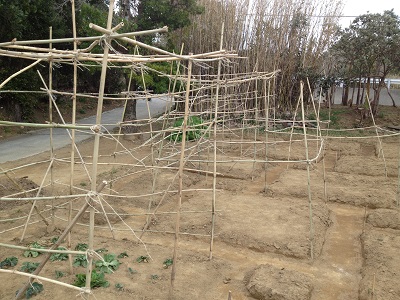 Close
Up Close
Up
The trellis worked out great and the amount of veggies produced went way up.
In addition, the trellis turned into a green wall which got a lot of attention
from the locals.
Be sure to make your trellis on the north side of your farm to avoid the
vertically growing vines from cutting off the sun from the other beds. |
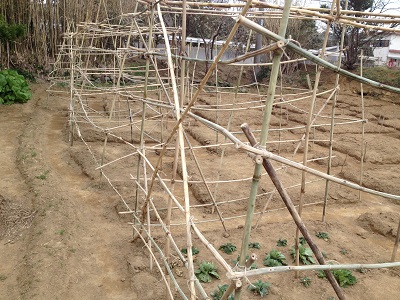 Additional
Support Additional
Support
This is a view of the north side of the trellis.
Notice the angled piece of bamboo in the foreground. Make sure to put a few of
these in to give additional strength and support for the trellis. This is
especially important in a place like Tanegashima Island that gets typhoons and
really strong wind throughout the year.
Put one end of the bamboo in the soil and the upper end tied to the trellis,
with the piece at about a 45 degree angle. |
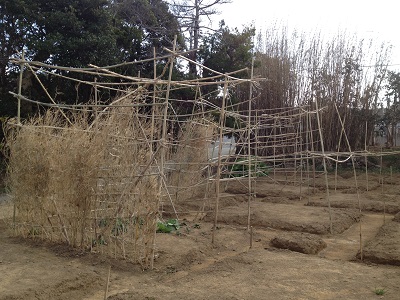 Vine Climbing Trellis Vine Climbing Trellis
The same bamboo pieces used to make the support trellis where also used to give
the vines something to hang on to. The tops of the bamboo pieces are filled with
small branches and leaves.
The small branches give the vines something to grow on while the leaves provide
protection from the wind until the vines are fully established.
Simply tie the leafy pieces of bamboo to the support trellis. |
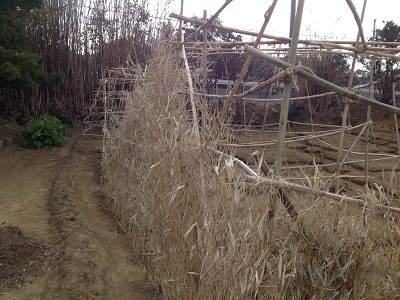 Another
View Another
View
A rear view of the climbing trellises along the north side of the farm. |
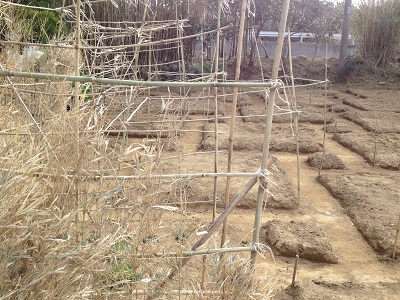 Close
Up Close
Up
Notice the numerous places vines can connect to while growing vertically up the
trellis. |
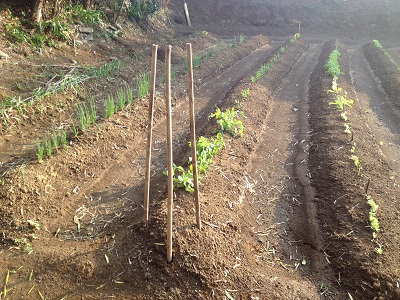 Veggie
Support Veggie
Support
Gosh bamboo is certainly turning out to be very usable in the farm.
I used three pieces to make this support tripod which was then tied together
at the top using jungle vines.
A few of these tripods were made along the length of the bed to provide strong
support for the jungle vines which were used to hold up the green peas. |
|
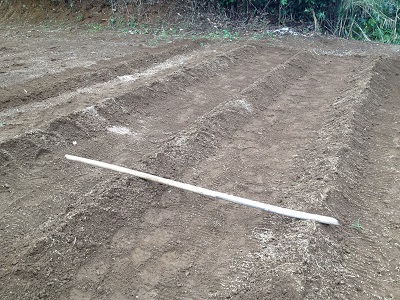 Measuring Pole Measuring Pole
This might seem a bit too simple to even put here but this pole proved to
be very useful for making farm beds and other farm work.
I found a piece of bamboo that had nodes (the solid ring looking area between
hollow sections) that were almost exactly 2 meters apart. This is the same
length as my 2 square meter beds I eventually went to one meter wide rectangular
beds in lieu of the straight line
beds....ah another story. |
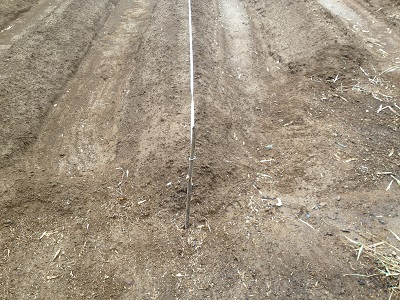 Tape
Measure Holder Tape
Measure Holder
Working alone in the farm?
Nobody to hold your tape measure?
No problem. Simply find a strong, thin piece of bamboo to hold the end of your
tape measure for you. |
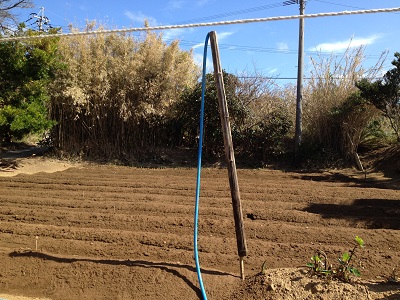 Elevated
Hose Connection Elevated
Hose Connection
This is a nice use for a piece of bamboo of medium thickness. Cut the bamboo to
whatever height you like leaving a hole (the hollow section of the bamboo) at
one end.
Then cut the other end of the piece very slightly
below the node to make a solid end. Then simply stick the
closed end of the piece in the soil and the hose connection in the upper, hollow
portion of the piece.
This is a great way to keep soil from getting all over the hose connection. |
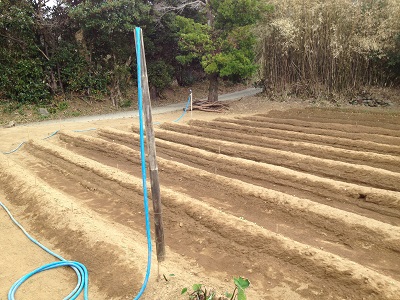 Close
Up Close
Up
This is a closer view of the bamboo farm hose connection holder. This end
is connected to the main hose coming from the house. In the distance you
can see the other end of the hose with the spray nozzle, which is also being
held up and off the soil with another piece of bamboo. |
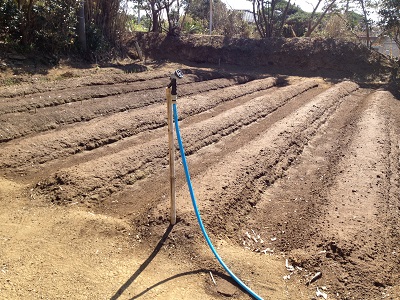 Hose Nozzle Holder Hose Nozzle Holder
This is a nice use for a piece of bamboo. Cut the bamboo to
whatever height you like leaving a hole at one end. Then stick the handle
of the hose nozzle in the hole.
This is a great way to keep soil from getting all over the hose nozzle. |
 Close
Up Close
Up
This is a closer view of the bamboo farm hose nozzle holder.
Be sure there is enough length in the open hollow section to hang the hose
nozzle. In addition, be sure to cut the bamboo directly on the
outer side of the node (the solid ring looking area between hollow sections)
on the end to be inserted in the soil. This results in a closed piece of bamboo and keeps soil and insects from getting into the hollow section of the
piece. |
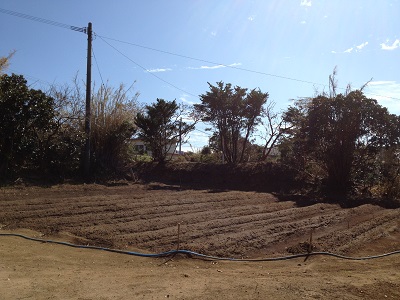 Hose Guide Hose Guide
A few pieces of bamboo and voila, a great way to keep the hose from destroying a
line of seedlings.
Put a really strong piece of bamboo at the end of each farm bed to
protect anything growing in the bed from being overrun by the hose. |
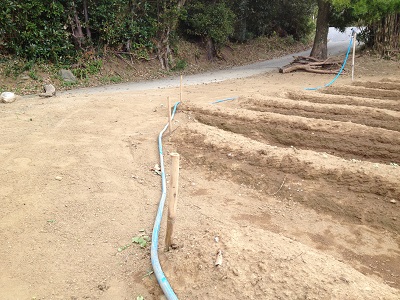 Close
Up Close
Up
This is a closer view of the hose guides.
Again, be sure to cut the bamboo directly on the
outer sides of each node (the solid ring looking area between hollow sections)
before inserting the pieces in the soil. This results in a closed piece of bamboo at each end
and keeps soil and insects from getting into the hollow section of the piece. |
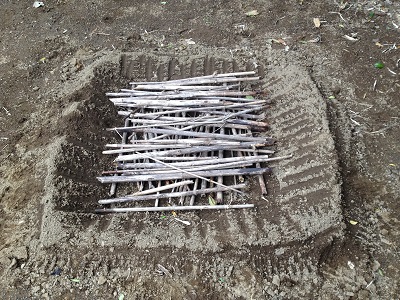 Aerate Your Piles Aerate Your Piles
A compost pile requires air in order for the materials to properly decompose.
Bamboo is a fantastic way to provide this air from the bottom up.
Simply take pieces of bamboo and put them in the compost pile space and line
them up next to each other.
Then add another layer on top lined up perpendicular to the first layer.
You can do this alternate layering as much as you want. More layers means more
air getting into the compost pile.
The really cool thing is eventually the bamboo will also decompose and provide
plenty of "brown material" for the finished compost. |
|
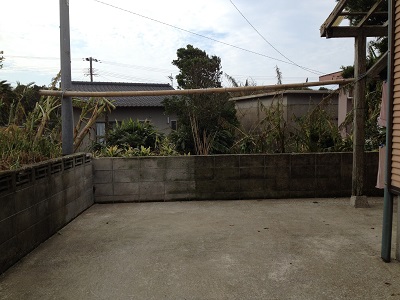 Blanket Hanging Pole Blanket Hanging Pole
Hey anybody up for a few non-farm related uses?
People in Japan hang their blankets and futons outside anywhere they
can find a space. Tanegashima is no exception, however, with most of the homes
being only one story, there is usually no balcony to use for this purpose.
The solution, a nice long and thick piece of bamboo.
This piece was attached to a utility pole at one end and a patio support at the
other. |
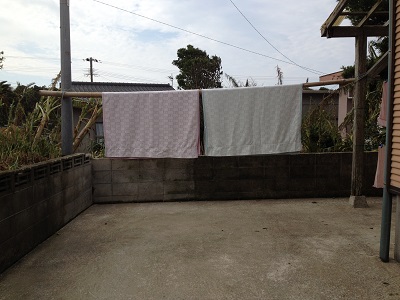 Blankets
Hanging Blankets
Hanging
Blanket hanging pole with um....blankets hanging.
This same piece of bamboo is also being used as part of a patio cover frame....see
next picture. |
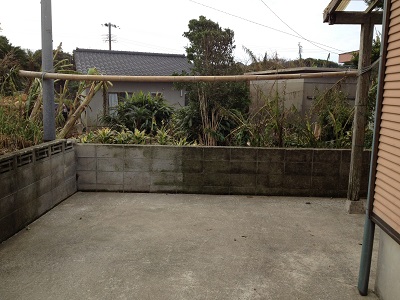 Patio
Cover Frame Patio
Cover Frame
Do you recognize this bamboo pole? Yup, the same pole used to hang blankets.
This piece served double duty as it also became the base of a nice patio cover
frame.
This wonderful piece of bamboo was found washed up on the beach and turned out
to be a perfect fit for this project. |
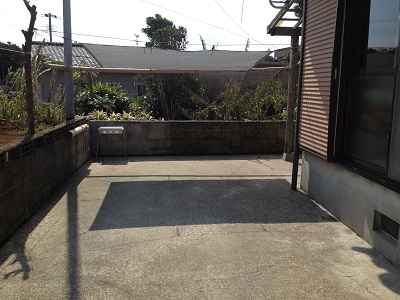 Patio Cover Patio Cover
The patio cover was attached to the bamboo using looped bungee cords with a hook
at one end. The bungee cords went around the bamboo, through the loop, and then
were tied leaving the hooks hanging.
Then the hooks were inserted into the holes around the perimeter of the patio
cover which is a really strong vinyl mesh sheet.
The bungee cords worked out great. Due to their flexibility, they are able
to allow the patio cover to sway with the wind instead of being blown away. |
 Patio Cover
Finished Patio Cover
Finished
Hey anyone up for a barbecue?
This same piece of bamboo is also being used as a blanket hanging pole. We
simply remove the hooks from the patio cover when hanging blankets. |
 Barbecue Fuel Barbecue Fuel
What about barbecue fuel?
Getting the barbecue going has never been easier. Putting a few pieces of
completely dried out bamboo in the barbecue makes a huge difference.
The bamboo burns really hot and lasts pretty long too. Be sure not to use fresh green bamboo in
the BBQ. Fresh bamboo has a high moisture content and when heated up it can
actually explode. |
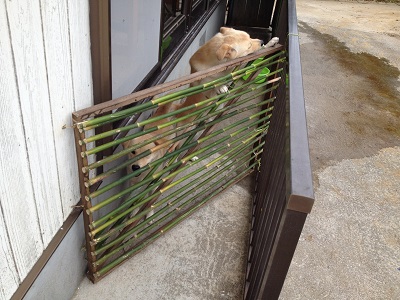 Yard Gate For Dogs Yard Gate For Dogs
Many things on this island are more expensive than mainland Japan and wood is no
exception, that is if you can even find the type you need.
No worries though. Bamboo worked out perfectly for this project.
I used fresh pieces of bamboo to make this dog gate since there was less chance
of them splitting when screwed into the wood frame.
Our dogs are chewers and enjoyed working their way through a few of the pieces
of bamboo which were then simply replaced with others.
Disclaimer. Hey before all of you dog lovers send complaint messages, be assured
this was not the only space for these two medium sized dogs. Around the corner
of the house was a large, partially covered storage shed, which they had total
access to. The wood gate in the background was closed to keep them in the
foreground for this picture. |
|
|